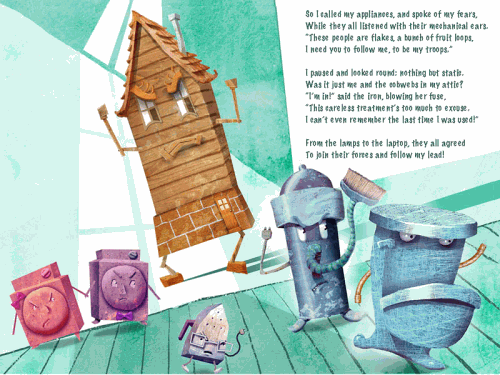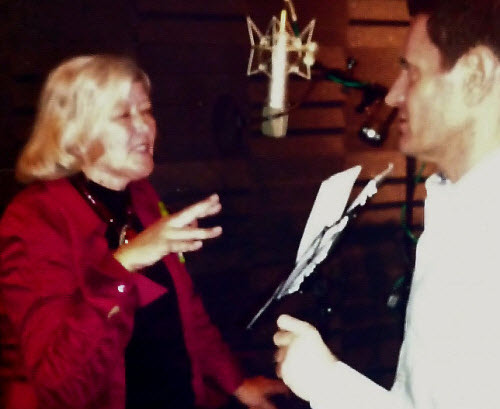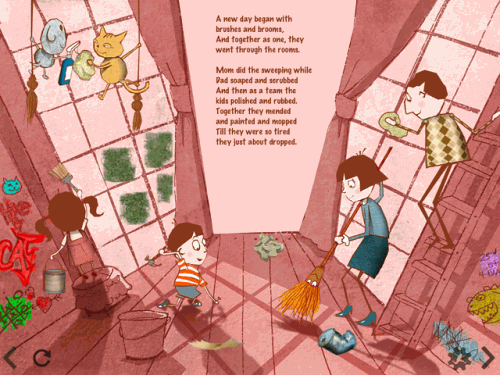The Art Of Storytelling Around An App
Deciding on the story for your app requires careful thought and creativity. Most stories have a lesson, and indeed most apps do, too. As all app developers know, the production process follows a formula, and it’s no different when adapting a book into an app.
Every app tells a story. Apps like Pandora tell the story of music; apps like Tip N Split tell a story of a calculator; and apps like Temperature tell the story of weather. Then we have storybook apps like Alice for the iPad, which literally tell stories!
The story of the cluttered app market is well known! Biz Report recently reported that the number of app downloads is estimated to reach 56 billion in 2013. And the San Francisco Chronicle has just reported that over 700,000 apps are for sale in the iTunes Store. Getting noticed is a major concern for app developers, and getting noticed sometimes requires not only a breakthrough app, but a compelling story.
For any app developer, conveying an app’s story at launch is critical. And just as important as promoting the story of your app is developing a story around the app that promotes the app’s story, that helps the app to stand out on digital store shelves, and that differentiates the app from its competitors.
To that end, what follows is a story about storytelling for a storybook app!

“The House That Went on Strike” and her troops.
The Big Brands And Storytelling
Storytelling has been described as a method of explaining a series of events through narrative. Storytelling is used by marketers as a tool to entertain or to establish an emotional connection; it can be employed to illustrate a concept, to steer an argument and to encourage consumer loyalty. “The digital age equals a commitment to storytelling,” explains Marian Salzman, Havas PR North America CEO and author of the annual trend-spotting book What’s Next: What to Expect in 2013. “As such, brands are always looking to create stories around their products as a way to relate more personally to the consumer and, at the same time, capture the attention of the media. Storytelling was a trend in 2012, and will continue to be on the upswing in 2013.”
Indeed, this year’s Super Bowl advertisements and viral videos reinforced the focus on storytelling by brands. Taco Bell told a tale of seniors gone wild, a group of elderly partiers who escape their beds and hit the pools and bars one evening, ending their night by eating at Taco Bell. The spot tied the brand to youthfulness. Volkswagen’s clever use of famous YouTube “anger” stars dancing in a field to “Come On Get Happy” — the theme to ’70s sitcom The Partridge Family — tied the brand to the emotive story of happiness.
Taking a page from the major brands’ use of storytelling and applying it to the release of its book app, Jumping Pages sought ways to tell the story of “The House That Went on Strike.” And as the team did with its first production, “David and Goliath” (hopefully you read about that in “The Art of Launching an App”), it set out to provide backstories that support the house’s strike and to provide promotional opportunities for storytelling.
The House That Went On Strike
It all began one day while filmmaker and founder of Jumping Pages, Rania Ajami, was juggling her job, two kids and her home — and the home unfortunately seemed to be losing out. “One day, I just felt like I couldn’t keep up and, feeling unappreciated, threatened to go on strike. Then, as I looked around my own home, it occurred to me that with the TV blaring, lights burning, washer and dryer continually spinning, a kitchen resembling a 24-hour diner — maybe the house wanted to strike, too, and that’s when the idea for the story struck!”
Thus, “The House That Went on Strike” was born. The rhyming tale of an errant family that repents after its neglected house and appliances go on strike became a critical hit. MyMac called the story the “epitome of interactive books.” The ultimate critic in the book industry, Kirkus, hailed the book app as “a lesson… delivered in a blend of equally lively sound, art and animation.” And the storytelling that the team generated to promote the book provided a myriad of media stories. The book app was positively featured in political, publishing and home stories in newspapers, magazines and websites around the US. But achieving these results wasn’t easy. The process was well thought out.
Building Stories
As all app developers know, the production process follows a formula, and it’s no different when adapting a book into an app. The Jumping Pages team began the production route for “House” by writing a story about how a home would lead her troops (i.e. her appliances) on a strike to teach the residing family a lesson. The script was then transformed into a sequence of panels for the iPad, with each panel containing interactive and animated scenes that directly related to the story.
With the prose and plans for each panel in place, the company’s graphic artist, Walter Krudop, added the wonderful images, and the production team completed the visual, aural, musical, animated and interactive components. The next step was to choose a narrator. The team wanted a celebrated mom, one who had a background as a leader, because calling a strike would require the heft of an authority figure.
It’s easy for creative developers to fall into the trap of insisting on a trained actor to read their story. Naturally, you want the quality of the narration to match the quality of the app and the story. Yet a trained actor might not draw attention to your app or have the background to storytell around the app. Therefore, just as designing, coding and building an application take some creativity, so does selecting a voice for the app. For “The House That Went on Strike”, Jumping Pages rocked the house with its selection.

John Casey with Congresswoman Pat Schroeder during the recording of “The House That Went on Strike.”
Former congresswoman Pat Schroeder is not only a member of the National Women’s Hall of Fame, but is a former presidential candidate, the first mother to serve on the US House Armed Services Committee, and the former CEO of the Association of American Publishers. Schroeder was literally a “house mom,” and her memoir, 24 Years of House Work… And the Place Is Still a Mess, was a complementary metaphor for the Jumping Pages story.
She was the perfect choice not only because of her background, but because she excels in narration and has since received numerous plaudits for her work. Finally, she helped to provide multiple storytelling tracks.
In The News
One way to storytell is to find something in the news that relates to a component of your app. By anyone’s standard, members of the US House of Representatives didn’t get along too well in 2012, and its low approval ratings and ongoing negative headlines bore that out. As a former member of this esteemed body, Schroeder had firsthand experience dealing with that rancorous House. In fact, she had suggested that one way to get the representative body to work together was to call for a House strike.
Using that angle, prominent political publications in the US, including the National Journal and Roll Call, wrote articles about Schroeder’s narration of the app and how its message could help the US House become more orderly. As Roll Call reports:
"Schroeder said she used to dream of leading her colleagues on a strike against “the messy House” they created and hopes that the house in this story will inspire Congress to take similar action. “They oughta strike,” she said about Congress’ ongoing fights in the Roll Call article."
Effect On The Industry
As book app developers know, the market is exploding. Some book apps are quite fancy, with a lot of interactivity, animation, and even videos and games embedded within. “The House That Went on Strike” contains interactivity, sounds and animation that relate directly to the story. And that is the difference. It’s a storybook first, and it’s important for this story to be told.
After leaving the House of Representatives, Pat served for over 10 years as the head of the Association of American Publishers, representing the top publishers in the US. Thus, she provided an authoritative voice about books and was recognized as a leader in the publishing industry. Furthermore, she could lend a stamp of approval about a book app, particularly one targeted at children.
While most parents have to weigh the pros and cons of downloading a book for their kids on an iPad, Pat could offer reassurance that the app was just fine for kids, provided that it was a storybook first and that any additional components of the app tied directly to the story. Consequently, she penned a blog post in the Huffington Post’s books section titled “A House Grandma’s iPad Story,” which spoke at length about her experience working on “The House That Went on Strike” and offered insight into how books should be produced for the mobile format (it’s even perhaps a must-read for developers who produce kids content for the mobile platform).
Furthermore, Pat’s experience in the industry helped the app get featured in Publisher’s Weekly, the bible of the publishing industry.
Teaching A Lesson
Most stories have a lesson, and indeed most apps do, too. “The House That Went on Strike” provided a lesson not only for kids, but for their parents: treat your home with respect. And while newspapers, magazines and blogs about the home traditionally feature decorating and “fashion” tips, the Jumping Pages team worked to create a story angle about how the app could help families come together to take care of their home.
The result was a nationally syndicated newspaper column by prominent home columnist Marnie Jameson, which appeared in over 30 newspapers in the US, including the San Jose Mercury News (the newspaper of Silicon Valley), the Denver Post and the Orlando Sentinel. The headlines from across the country, chosen by editors of the papers, ranged from “House on Strike: All Must Pitch In” to “Pat Schroeder Narrates a Book on Keeping the Home Tidy” to, appropriately enough, “The House That Went on Strike.” The story even made Marnie’s year-end “Lessons Learned in 2012.”
Media Success
Indeed, the “The House That Went on Strike” was a lesson in successful storytelling. The app generated dozens of media stories about several storytelling themes. The book app, and the slew of publicity around it, helped Jumping Pages secure work for a soon-to-be-released animal app for kids by a prominent animal expert, and a groundbreaking app for kids related to the entertainment industry. In addition, the company plans a sequel to ride the success of the original “House” production.
Storytelling is fun for kids, adults and the media, and it can be fun for app developers, too. When promoting your app, remember that it’s not always about the final product, but perhaps rather about something indirectly related to it. The best brands sell to you by telling stories around their products. Similarly, “The House That Went on Strike” became a media darling and a hit on the strength of its heartwarming storytelling. As a media success story, the “House” cleaned house!
Four Tips On Storytelling
Deciding on the story for your app will require some careful thought and creativity. The first rule of thumb is to find a story that will resonate with a very specific niche audience, and then determine the optimal time to launch the app along with the story.
For example, the app KillsWitch, which makes it easy to entirely eliminate your ex’s presence from your Facebook timeline, was launched this past Valentine’s Day. Why? Simple: the developers created a story about all of the lonely and scorned lovers who seek revenge for their plight on the day traditionally celebrated for love. The app’s story had a clear demographic in mind, and it allowed the media to take an opposing angle for stories around the holiday.
Here are some other tips to keep in mind when crafting your app’s story:
- Emotional component
Does your app capture memories (Instagram) or make you happy (Emoticon App) or sad (Crying Translator)? Find the emotion that best matches your app, and find a reason for a niche audience to laugh or cry about it. Will your app make people cry? Create a story about grown men crying, and launch it on World Smile Day. - Newsworthiness
If something is making the news, grab hold of it. Speaking of which, seasonal stories are always a good hook — for example, the Boating Weather app is tied to spring, and the TanningBooth app gives you a “tan” in winter. In addition, marking an anniversary is always a great way to keep your story newsworthy; for example, Jaeger-LeCoultre’s app marks the brand’s 180th anniversary in 2013, and the financial app Wonga Bazaar launched on the 25th anniversary of Black Monday. - Industry effect
An app can have an impact on the industry it was created for — and some crazy stories can be woven to grab that industry’s attention. Was Vine’s story about pornography? - Lessons learned
Does your app provide insight, have a special message or raise awareness? Climate Mobile provides information and lessons about global warming, particularly relevant this year as the subject gains traction. Does your app promote a lesson in thriftiness, like ExpenseTracker; a smart launch at the start of the holiday shopping season might appeal to stingy dads.
Further Reading
- Recent Trends In Storytelling And New Business Models For Publishers
- Content Strategy: Optimizing Your Efforts For Success
- Make Your Content Make A Difference
- Better User Experience With Storytelling



 Register!
Register!

 Flexible CMS. Headless & API 1st
Flexible CMS. Headless & API 1st


